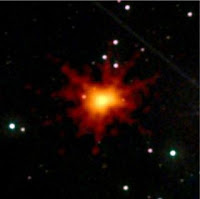Sky Study 1: Brightest Star Explosion
On June 21, The bright X-ray burst blinded Swift orbiting observatory and the observatory's software ignored it as if it were an anomaly.
"The burst was so bright when it first erupted that our data-analysis software shut down," said Phil Evans of Britain's University of Leicester, who discovered the burst when he was going through some recorded data from Swift.
"The intensity of these X-rays was unexpected and unprecedented," Neil Gehrels, Swift's principal investigator at NASA's Goddard Space Flight Center in Maryland, said in a statement.
Gehrels said the burst, named GRB 100621A, is the brightest X-ray source that Swift has detected since it started looking for them in 2005.
"Just when we were beginning to think that we had seen everything that gamma-ray bursts could throw at us, this burst came along to challenge our assumptions about how powerful their X-ray emissions can be," Gehrels said.
"So many photons were bombarding the detector each second that it just couldn't count them quickly enough. It was like trying to use a rain gauge and a bucket to measure the flow rate of a tsunami."
When a star explodes, radiation travels at the speed of light in all directions. Gamma rays reach Earth first, followed by X-rays. This particular star was 140 times brighter than the brightest continuous X-ray source in the sky i.e. a nearby neutron star.
The most interesting fact is that this particular star died 5 billion years ago, far beyond our own Milky Way galaxy, and it took this long for the radiation to reach the Earth.
Labels: Brightest Star explosion, death of a star



0 Comments:
Post a Comment
<< Home